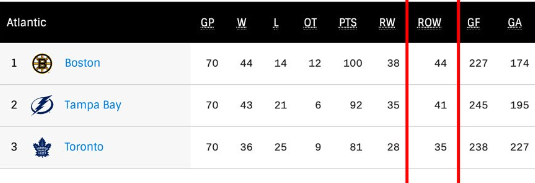Understanding ROW in Hockey
(Regulation plus Overtime Wins) ROW in hockey is a crucial metric, introduced during the 2010-11 NHL season. This measure helps differentiate wins achieved during regulation or overtime from those secured through shootouts. In instances where teams have identical points and regulation wins, those with a higher ROW are placed above in the standings.
Initially, ROW was the primary determinant in resolving ties among teams with equal points at the end of the regular season. However, starting with the 2019-20 season, the NHL prioritized the Regulation Wins (RW) column over ROW for tie-breaking purposes.
The importance of ROW lies in its emphasis on non-shootout victories, underscoring their significance in the standings tie-breaker criteria.
To fully grasp the impact of ROW, examining the NHL standings is an excellent starting point.
Scoring Points in NHL Standings
In NHL games, teams can score points through several outcomes. Understanding these can help fans and players alike grasp the standings more comprehensively.
Here’s a simplified breakdown of the points system:
- Regulation Win: 2 points
- Regulation Loss: 0 points
- Overtime Win: 2 points
- Overtime Loss: 1 point
- Shootout Win: 2 points
- Shootout Loss: 1 point
Key observations include:
- The only scenario where a team earns no points is with a regulation loss.
- Teams losing in overtime or a shootout still receive one point.
- Regardless of the game phase (regulation, overtime, or shootout), a win always results in two points.
Origins of the ROW Metric in NHL
The Regulation plus Overtime Wins (ROW) metric was introduced to address concerns within the hockey community about how victories are valued differently. Not all fans and players regard the outcomes of hockey games equally, particularly when it comes to shootouts. These are often seen as less representative of team skill, being more akin to individual skill contests or even likened to the randomness of flipping a coin.
The NHL recognized these concerns, understanding that many did not view shootout wins as equivalent to those achieved in regulation or overtime. This perspective led to the need for a tiebreaker system that fairly reflected a team’s performance over the season without overvaluing shootout wins.
Therefore, to maintain the integrity of team competition and ensure that playoff qualifications reflected genuine team capabilities, the NHL prioritized wins in regulation and overtime. Thus, ROW was established as a crucial tiebreaker in the standings, providing a clear hierarchy of victory worth and ensuring teams with more in-game victories had rightful standing advantages.
Impact of ROW on NHL Standings
The Regulation plus Overtime Wins (ROW) plays a pivotal role in determining team rankings in the NHL standings, especially when teams are tied in points at the end of the season. Here’s an illustration using four teams to show how ROW influences playoff qualifications.

In a hypothetical scenario:
- The Chicago Blackhawks and the Dallas Stars both finish with 93 points. However, the Blackhawks have a higher ROW count, with 42 of their 43 wins coming from regulation or overtime games, compared to the Stars’ 40. This higher ROW secures the Blackhawks a higher position in the standings due to the tiebreaker rule.
- Similarly, the Colorado Avalanche and the Edmonton Oilers each accumulate 90 points. The Avalanche, having 6 more regulation plus overtime wins than the Oilers, are ranked higher, directly impacting playoff entries as only the top 8 teams advance.
Tiebreaking Procedures When Teams Are Equal in ROW
When teams in the NHL are tied in terms of Regulation plus Overtime Wins (ROW), additional criteria are used to determine their standings:
- Head-to-Head Record: The first tiebreaker considers the points earned in games played against each other. If the teams have competed an uneven number of times at each other’s arenas, the first game at the venue where more games were hosted is excluded from the comparison.
- Goal Differential: If the head-to-head record does not resolve the tie, the difference between the goals scored and goals allowed throughout the regular season is examined. The team with the greater goal differential ranks higher in the standings.
Read Also: What is FOW in hockey?
Conclusion
The Regulation plus Overtime Wins (ROW) metric plays a crucial role in shaping NHL standings by valuing non-shootout victories more heavily in tiebreaker situations. This approach provides a balanced assessment of team performance throughout the season, favoring wins obtained during regular play rather than shootouts. As a key element in determining playoff eligibility, ROW underscores the importance of collective team prowess and strategic execution in the highly competitive arena of professional hockey.
FAQ’s: ROW in hockey
What does “Regulation and Overtime Wins” signify?
Regulation and Overtime Wins refer to the total victories a team secures within the standard game time or during the overtime period, not including wins obtained through a shootout. This metric is crucial in distinguishing teams based on their capacity to secure wins directly, rather than through shootout successes.
Why is ROW crucial in hockey rankings?
ROW stands as a critical statistic in hockey as it clarifies a team’s ranking within the league standings. When teams accumulate equal points, the one with a higher ROW—which indicates wins during regulation or overtime, excluding shootouts—is ranked superior. This measure offers a more accurate assessment of a team’s ability to win games outright.
How does ROW influence NHL tiebreakers?
In the NHL, when teams tie in points, the first criterion for breaking the tie is the ROW, which counts wins in regulation and overtime but excludes shootout victories. This is followed by other tiebreakers like head-to-head records and goal differentials. Essentially, ROW can decide playoff qualifications and seeding positions, highlighting its importance in league standings.
Does a shootout victory impact a team’s ROW?
No, a shootout win does not affect a team’s ROW value. ROW only includes victories achieved during regulation or overtime, with shootout wins tallied separately. This distinction ensures that ROW reflects a team’s ability to win within the standard or extended game time, excluding shootouts.
What determines a team’s ROW?
ROW is determined by totaling the number of games a team wins during regulation time or overtime, specifically excluding any victories obtained via shootouts. This calculation simply counts these outright wins without considering any other elements.
Can a team with a higher ROW have fewer total points?
Yes, a team can have a higher count of regulation and overtime wins (ROW) yet accumulate fewer total points compared to another team. This discrepancy occurs if the team with fewer total points has secured a greater number of shootout victories, which do not contribute to the ROW tally.
Does ROW influence team strategies during regulation or overtime?
While the ROW value itself does not directly dictate team strategies, it mirrors a team’s emphasis on securing wins during regulation or overtime, rather than depending on shootout victories. Teams might strive to enhance their ROW to bolster their position in league standings.



